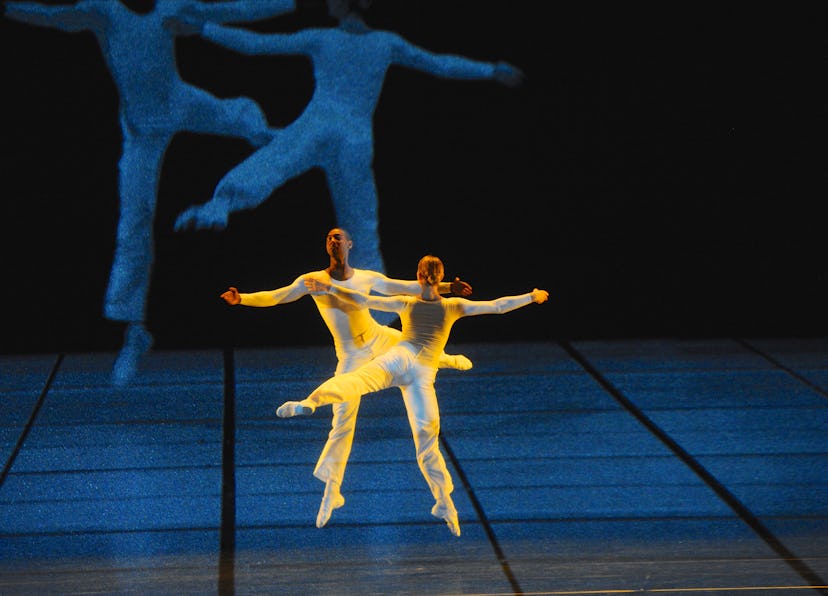“Dance Reflections” Celebrates Movement in All Its Forms
The three-week festival in London is the first of what will become an ongoing global project produced by Van Cleef & Arpels.

The connection between Van Cleef & Arpels and the world of dance dates back to the late 1940s, when the fine jewelry house began crafting gemstone-studded brooches in the shape of elegant young women, mid-pirouette. One of its founders, Claude Arpels, was a great lover of ballet and a friend of George Balanchine, the legendary choreographer, who held a press conference to announce the premiere of his 1967 ballet Jewels at the Van Cleef & Arpels boutique in New York City. (Legend has it that Balanchine was inspired by the shop’s glittering window displays, which he passed by on his daily walks down Fifth Avenue.)
In the decades since, the maison has supported various dance initiatives, from Benjamin Millipied’s L.A. Dance Project to collaborations with companies and theaters around the world, which they doubled down on during the pandemic, when many troupes were unable to perform for long stretches of time. This year, they’re taking the relationship to a new level by producing a festival called Dance Reflections, which runs through March 23 in London, and is the first edition of what will eventually become an annual event, held in a different global city each year.
The Tate Modern is one of three venues that will be showcasing contemporary dance performances through the end of March.
This year’s festival features 17 live performances, as well as screenings of dance films and panel discussions, in three venues across London: The Royal Opera House, Tate Modern, and Sadler’s Wells. The works being performed include examples of seminal choreography from the 1970s and ‘80s, experimental pieces from up-and-coming artists, and re-interpretations of early contemporary motifs and methods by a younger generation of creatives. “The founding family were lovers of opera and ballet. Ballet inspired them, inspired their jewelry, inspired their creations,” says Van Cleef & Arpels President and CEO Nicolas Bos. “That inspiration is still cherished. But the world of dance, obviously, is much wider than classical ballet.”
Highlights of the festival’s opening week reflected the breadth of styles, practices and influences that make up that world. Even for those whose knowledge of dance is limited to the handful of ballet classes they took as a child, there are plenty of ways in: “What’s driving this initiative is the idea of education, of transmission, and of sharing the contemporary patrimony of dance with the widest possible audience,” Bos added. Rather than presenting contemporary dance as a rarefied art form that can only be enjoyed by a select group of experts, the festival format showcases the various ways that dance can connect with people at a purely emotional level—and the overlap between dance and visual arts, design and music.
A trio of dancers perform Olga Maciejewska’s Bombyx Mori, which makes use of billowing silk costumes.
At Sadler’s Wells, a venue in Clerkenwell, 30 dancers from the Lyon Opera Ballet company performed Dance, a 1979 collaboration between the choreographer Lucinda Childs, the musician Philip Glass, and the visual artist Sol Lewitt. It’s a layered, virtuosic piece, with an energetic soundtrack by Glass and fascinating video projections by Lewitt that left the audience mesmerized. In a smaller theater in the same complex, Brigel Gjoka and Rauf “Rubberlegz” Yasit performed a quiet, sometimes mournful duet called Neighbours, which began in complete silence and ended accompanied by a live musical performance by Rusan Filitzek.
At the Royal Opera House, choreographer Olga Maciejewska showcased Bombyx Mori, a trio that pays homage to the midcentury master Loïe Fuller through the use of billowing silk costumes, which dancers whipped around the stage to approximate flapping wings and abstract shapes.
At the Tate Modern, which just acquired the American choreographer Trisha Brown’s postmodern masterpiece Set and Reset, from 1983, various interpretations of Brown’s work will be presented in the museum’s underground “Tanks” spaces. The piece, which includes a set installation by Robert Rauschenberg, music by Laurie Anderson, and lighting design by Beverly Emmons, is being performed in its original form by the London-based troupe Rambert. Later this month, a performance lecture series called Set and Reset / Unset begins, which will examine the principles and process behind the piece. And for Set and Reset / Reset, the Candoco Dance Company will reconstruct the original choreography, adapting it for a new era.
For anyone who happens to find themselves in London this month, securing a ticket to any performance (or even one of the Royal Opera House’s film screenings, like Merce Cunningham and Elliot Cameron’s Beach Birds for Camera) is a worthy endeavor. The rest of the world can rest easy knowing that this year’s Dance Reflections is just the beginning—there will be much more to come, perhaps in a city near you.